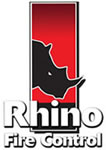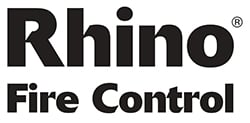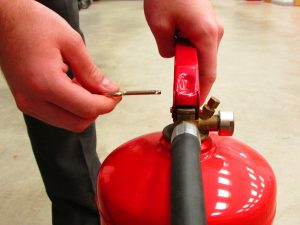
How to use a Fire Extinguisher
According to a study carried out by FETA and IFEDA, 80% of all fires in the UK are extinguished through the use of a fire extinguisher. Understanding how to properly use a fire extinguisher – and the different types of fire extinguishers is an essential skill that trained fire wardens and employees should be familiarised with. At Rhino Fire Control we provide full fire safety demonstrations and training but this blog post can act as a useful reminder of the key points to understand. It is critical to carry out regular maintenance on fire extinguishers to ensure they function fully.
Please note that fire extinguishers are ONLY suitable for early stage fires. If a fire is taller than YOU, you need to use more than one fire extinguisher to extinguish the fire or fire is spreading rapidly, then evacuate the building immediately and contact the fire brigade. Protection of Life & Health is of first importance and Protection of Property comes next.
Understanding the Different Types of Fire and The Correct Extinguishers to use
Using the incorrect type of Fire Extinguisher could be dangerous. Fire extinguishers have distinct classes and contents that determine which types of fire they are suitable for. Before using a fire extinguisher, you need to identify the class (type) of fire that is occurring.
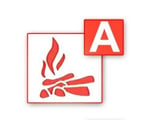 Class A Fires
Class A Fires
Class A fires are those composed of solid materials including wood, paper and plastic. If a fire is class A it cannot contain chemicals or electricals.
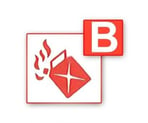 Class B Fires
Class B Fires
Class B fires are fires containing flammable liquids such as petrol and oil.
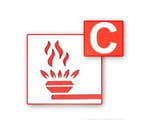 Class C Fires
Class C Fires
Class C Fires are gas fires from flammable gases like propane and butane.
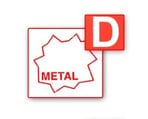 Class D Fires
Class D Fires
Class D fires are metal fires such as magnesium or titanium.
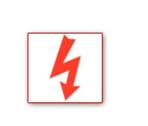 Electrical Fires
Electrical Fires
Electrical fires (sometimes referred to as Class E Fires) are fires which are generated by electrical equipment such as faulty motors, and broken cables.
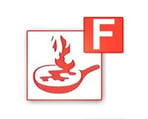 Class F Fires
Class F Fires
Class F Fires are those involving fat or cooking oils and are most commonly kitchen fires.
Types of Fire Extinguisher
Foam Spray Fire Extinguishers
Foam fire extinguishers are the most versatile extinguisher and can be used to fight Class A and Class B fires – fires containing solids and liquids. These extinguishers are not suitable for fighting electrical fires but are significantly less dangerous if they are accidentally sprayed onto one. Foam extinguishers are one of the most common and recommended extinguishers.
CO² Fire Extinguishers
CO2 fire extinguishers are the second most common type and are primarily used for fighting electrical fires. They are also suitable for Class B liquid fires. These are commonly used in offices and other electrical heavy areas. Note that as CO² is a gas there is no post fire security – which means fires can reignite. When using a CO2 fire extinguisher be sure to monitor the fire (or extinguished fire) carefully or, if in any doubt, phone the fire brigade.
Water Fire Extinguishers
Water based fire extinguishers are still the most common across the UK. They are cheaper and easier to maintain than most types, but can only be used on Class A fires involving solid materials.
Dry Powder Fire Extinguishers
Dry powder fire extinguishers are multi-purpose and can be used to extinguish Classes A, B and C successfully. They are suitable for solid, liquid and gas fires. However, bear in mind that in the event of a fire involving flammable gases, the gas supply must be isolated before attempting to extinguish the fire.
Use of powder extinguishers indoors is not recommended as they can obscure your vision, cause damage to sensitive equipment and potentially create breathing difficulties.
Wet Chemical Fire Extinguishers
Wet chemical extinguishers are specifically designed for oil and fat fires in kitchens and other areas. The chemical used in the extinguishant forms a soap type substance to prevent fire flare-up. Wet chemical is the best fire extinguisher to use in these types of environments – make sure you NEVER use water to extinguish a deep fat fryer/kitchen fire.
D Class Powder Fire Extinguishers
D Class Fire Extinguishers contain special powders designed to extinguish high temperature metal fires – such as those caused by the combustion of magnesium, titanium or aluminium. They are designed for specialist industrial use.
How to Use a Fire Extinguisher
Once you know what type of fire extinguisher you need, the operation of each types is similar. If in doubt remember that full instructions are written on the extinguisher. To use an extinguisher, follow the instructions below.
N.B. Never enter an area with fire if smoke is clouding your vision or if the fire has spread to a large area. The risks of asphyxiation or harm are not worth the risks and you should contact the fire brigade immediately after exiting the building.
Step 1: Check the Pressure
With the exception of CO² type, an extinguisher ready for use should have a pressure gauge with the needle in the green “V”. If it’s not then the extinguisher will not be suitable – you need to find another one that is appropriate for the fire. If the extinguisher has no pressure gauge, other clues such as missing pin or anti-tamper device should be looked for before attempting to extinguish the fire.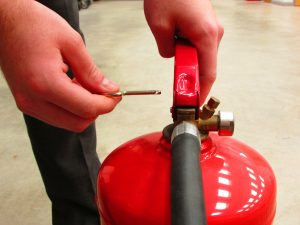
Step 2: Pull the Pin
Remove the pin from the fire extinguisher with a sharp twist and pull motion to break the anti-tamper device.
Step 3: Aim the Nozzle at the Base of the Fire
To extinguish fire you must remove at least one element of the Triangle of Fire – Heat, Fuel and Oxygen. To achieve this, aim the nozzle at the base of the fire to smother it.
Step 4: Squeeze
Squeeze the handles of the extinguisher gently to discharge the contents onto the fire.
Step 4: Sweep
Sweep the nozzle slowly from side to side until the extinguisher is empty, or the fire is fully extinguished. If the fire isn’t fully extinguished, it is too big for you to handle – evacuate the building and call the fire brigade.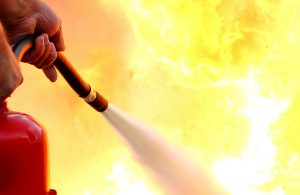
Step 5: Back Away
Even if a fire appears to be extinguished you need to be careful. Make sure you monitor the situation as flames can reignite for a significant time after a fire is put out. Contact the emergency services if necessary and always err on the side of caution.
After Fire Extinguishers Have Been Used
Whenever a fire extinguisher is used it will need to be refilled and re-pressurised by your maintenance service provider.
For more information on our services please get in touch with us directly. Alternatively, you can read more on our fire safety training here and our fire extinguishers here.
